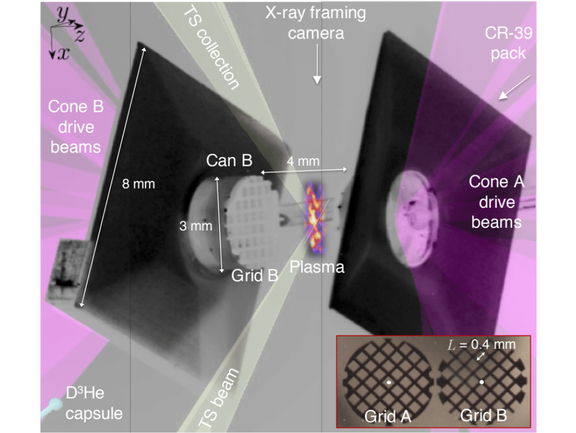In the latest article, published in the Proceedings of the National Academy of Sciences, the Turbulent Dynamo (TDYNO) team describes the laser-driven experiments they carried out at the Omega Laser Facility of the Laboratory for Laser Energetics (LLE) at the University of Rochester, where they previously demonstrated experimentally the existence of the turbulent dynamo mechanism in a plasma. In their more recent TDYNO experiments at Omega, they were able to achieve conditions relevant to the hot, diffuse plasma of the typical intracluster medium in which the turbulent dynamo mechanism is thought to operate. This feat was accomplished by leveraging laser beams whose total power is equivalent to that of ten thousand nuclear reactors to access plasma regimes that previous liquid-metal and laser-driven experiments could not. Using an extensive suite of plasma diagnostics, the scientists were able to clearly measure as a function of time the magnetic field amplification produced by this mechanism.
At the core of the astrophysical dynamo mechanism is turbulence. Primordial magnetic fields are generated with strengths that are considerably smaller than those seen today in galaxies and galaxy clusters. Stochastic plasma motions, however, can pick up these weak “seed” fields and amplify their strengths to significantly larger values via stretching, twisting and folding of the field. The rate at which this amplification happens differs for the different spatial scales of the turbulent plasma motions: theory and simulations predict that the rate of growth is large at the smallest length scales but far smaller at length scales comparable to those of the largest turbulent motions. The TDYNO experiments demonstrated that this may not be the case: turbulent dynamo – when operating in a realistic plasma – can generate large-scale magnetic fields much more rapidly than currently predicted by theoretical models.
These experiments are part of a concerted effort by the TDYNO team to answer key questions that are debated in the turbulent dynamo literature, establishing laboratory experiments as a component in the study of turbulent magnetized plasmas. The collaboration has built an innovative experimental platform that, coupled with the power of the OMEGA laser, as well as other high-power laser facilities, and supported by state-of-the-art numerical simulations, enables the team to probe the different plasma regimes and the associated non-linear processes relevant to various astrophysical systems.
Original publication:
Time-resolved turbulent dynamo in a laser plasma
Archie F. A. Bott, Petros Tzeferacos, Laura Chen, Charlotte A. J. Palmer, Alexandra Rigby, Anthony R. Bell, Robert Bingham, Andrew Birkel, Carlo Graziani, Dustin H. Froula, Joseph Katz, Michel Koenig, Matthew W. Kunz, Chikang Li, Jena Meinecke, Francesco Miniati, Richard Petrasso, Hye-Sook Park, Bruce A. Remington, Brian Reville, J. Steven Ross, Dongsu Ryu, Dmitri Ryutov, Fredrick H. Séguin, Thomas G. White, Alexander A. Schekochihin, Donald Q. Lamb, Gianluca Gregori
Proceedings of the National Academy of Sciences Mar 2021, 118 (11) e2015729118; DOI: 10.1073/pnas.2015729118
